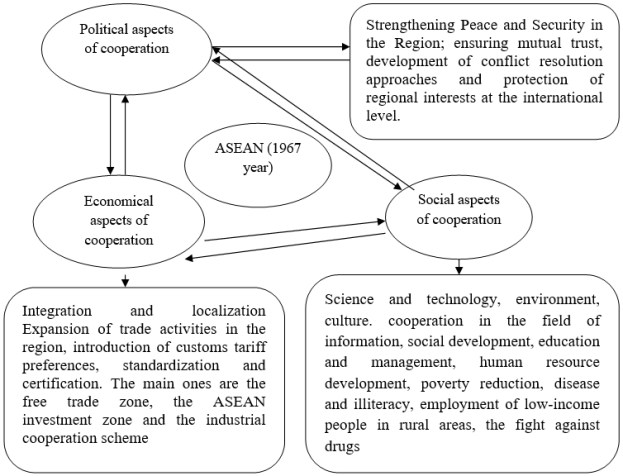It is known that integration process has been accelerating throughout the world. Developed countries have actively participated in this process. For example, EU is the best sample for integration process. The economy of EU countries is more powerful than other countries. Integration has developed in Asian countries. For example, ASEAN and APEC have efficiently worked and achieved its goals which set up. After gaining independence, the Republic of Uzbekistan has given priority to economic ties with the former Soviet republics and supported the idea of creating a CIS. Such cooperation is based not only on the territorial proximity and economic dependence of the Commonwealth, but also on deep historical, cultural and spiritual ties, as well as the common destiny of our peoples throughout the great historical period. In this article, these processes are expounded.
Keywords: ASEAN, economy, integration, international trade, cooperation, APEC.
The international economic integration has significance in globalization period. We analyze scientifically the concept of integration that this term is derived from Latin and it means «integration», «merger», «integration of parts into a whole». The term «international economic integration» was first used in the works of German and Swedish economists in the 1930s [1].
According to economists, international economic integration is understood as a high level of internationalization of production based on deep stable relations and division of labor between national economies, it leads to the gradual integration of the structure of reproduction in a number of countries.
Just as every economic concept has an object and a subject, there is also an object and a subject of international economic integration. In particular, goods, services, money and labor resources, which are the subject of production, scientific and technical cooperation and exchange, are the objects of international economic integration, while the economic parties engaged in international production, scientific and technical cooperation and exchange are the subjects of international economic integration. World experience shows that the goal of economic integration is considered to remove barriers to the free movement of goods, services and factors of production.
International economic integration is based on the following objective factors:
– Increasing internationalization of economic life;
– deepening of the international division of labor;
– specificity of global scientific and technological progress;
– increasing the level of openness of national economies;
– increased incomes in integrating countries;
– emergence of new trade flows;
– growth of economic well-being due to lower production costs, prices for goods and services;
– strengthening the economic position of the member countries of the integration union in relation to third countries;
– development of political cooperation in the region and strengthening of the political position of the member states of the integration union in relation to third countries.
The Asia-Pacific region is considered the third largest center of integration in the world economy. It was founded in 1967, the Association of Southeast Asian Nations (ASEAN) includes Brunei, Vietnam, Indonesia, Cambodia, Laos, Malaysia, Myanmar, Singapore, Thailand and the Philippines.
ASEAN's goal is directed to achieve the following objectives which were set out in the 1967 Bangkok Declaration: to ensure political stability in Southeast Asia, to form a customs union, and to promote the country's economic growth. In 1992, the Singapore Summit decided to establish a free trade zone (ASEAN) over the next 15 years [2].
The success of bilateral cooperation within this group links that economy of the ASEAN member countries has stable growth, their development can be compared, existence of mutual trade relations which have well-established, long-standing historical tradition, the regulation of forms of cooperation. ASEAN plans to reduce customs duties on 38,000 types of goods by an average of 5 % by 2000, and in 2002 decided to establish a free trade zone.

Fig. 1. The goals of ASEAN
The Asia-Pacific Economic Cooperation (APEC) has been operating in the Asia-Pacific region since 1989. APEC was established in 1989 at the suggestion of Australia to promote economic cooperation in the Pacific, initially including the United States, Canada, Australia, New Zealand, Japan, the Republic of Korea, Singapore, Malaysia, Thailand, the Philippines, Indonesia and Brunei. China, Hong Kong, Taiwan, Vietnam, Papua New Guinea, Mexico, Chile, Peru and Russia later joined APEC [3].
APEC is often referred to as the «APEC Forum» because this organization has consultative status. The purpose of the forum was defined in the Seoul Declaration of 1991 and includes:
– promoting the economic development of member countries;
– strengthening the multilateral trading system, taking into account the high level of economic interdependence of the member countries;
– liberalization of trade and investment.
In 1996, APEC members agreed to establish a free trade zone for 2010–2020. The Asia-Pacific Economic Community has official consultative status, but its working bodies set out regional rules for trade, investment and finance, and hold meetings of sectoral ministers and experts on cooperation in certain areas.
In conclusion, after gaining independence, the Republic of Uzbekistan has made great strides in the political and economic spheres. The active participation of our country in the world community and the pursuit of a multilateral economic policy in line with the national interests of Uzbekistan is an important condition for strengthening the position of our country in the world economy.
Uzbekistan's economic integration with the rest of the world is an important factor in improving the efficiency of the national economy, accelerating the development of science and technology, bringing nations and peoples closer, and improving the living standards of the population.
As Uzbekistan integrates into the world economic system, its international economic relations with developing countries near and far abroad are developing.
Uzbekistan's participation in integration associations such as the CIS and the Economic Cooperation Organization will further enhances the country's prestige in the world.
Uzbekistan has given priority to economic ties with the former Soviet republics and supported the idea of creating a CIS. Such cooperation is based not only on the territorial proximity and economic dependence of the Commonwealth, but also on deep historical, cultural and spiritual ties, as well as the common destiny of our peoples throughout the great historical period.
The goals of the Commonwealth are:
– the establishment of democratic states governed by the rule of law, the mutual recognition and respect of state independence and sovereign equality, the right to self-determination, equality and non-interference in internal affairs, the renunciation of any pressure, the peaceful settlement of disputes. Resolving human rights and freedoms, including the rights of minorities, and the honest observance of their obligations and other universally recognized principles and norms of international law;
– recognition and respect for each other's territorial integrity and inviolability of existing borders;
– strengthening the fundamental interests of peoples with deep historical roots, as well as good-neighborly and mutually beneficial cooperation;
– maintaining inter-citizen and inter-ethnic harmony.
Nowadays, the membership of the Republic of Uzbekistan in the CIS allows it to solve a number of important tasks in the interests of the national economy:
– development and improvement of cooperative economic relations aimed at supporting production and supply of the population with necessary products;
– Maintaining a leading position in the national market for a number of CIS goods, including the sale of traditional products;
– use of raw materials owned by the former Soviet republics;
– Guaranteed and safe use of transport communications serving Uzbekistan's export-import flow to third countries.
References:
- G.G’. Nazarova — Jahon iqtisodiyoti va xalqaro iqtisodiy munosabatlar. O’quv-uslubiy kompleks. T.:-2012. 233 b.
- Vaxabov A. V. Jahon iqtisodiyoti va xalqaro iqtisodiy munosabatlar — T.: «Voris» nashriyoti 2014. — 282–284 b.
- Vaxabov A. V. Jahon iqtisodiyoti va xalqaro iqtisodiy munosabatlar. O’quv qo’llanma — T.: «Moliya» — 2011. — 654–655 b.







